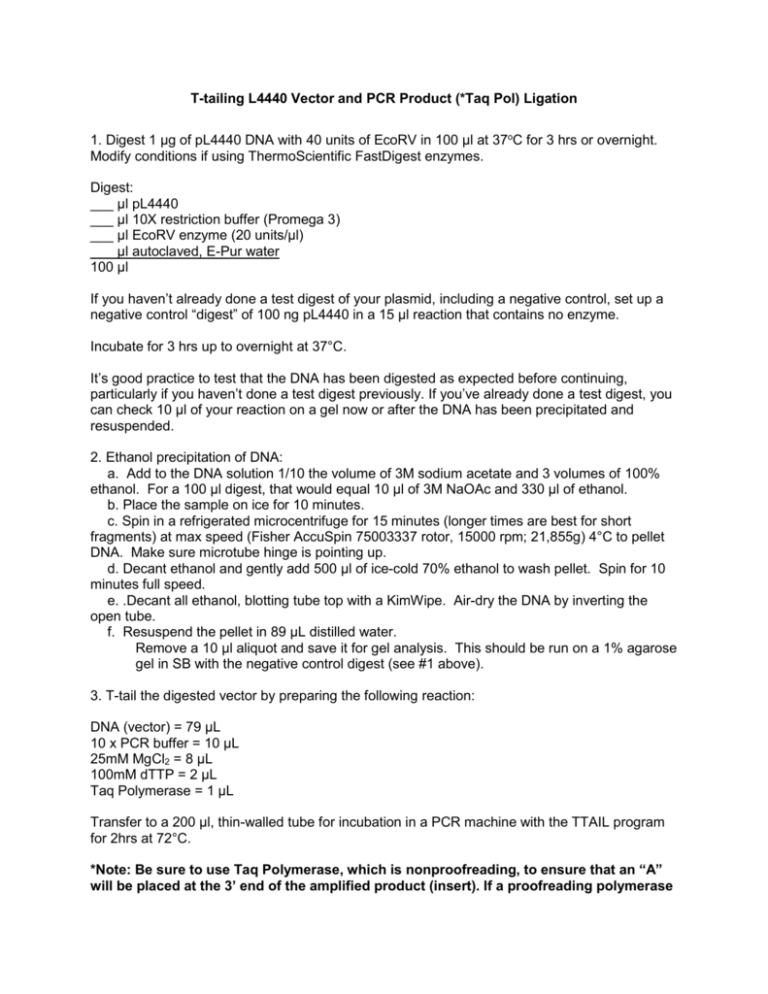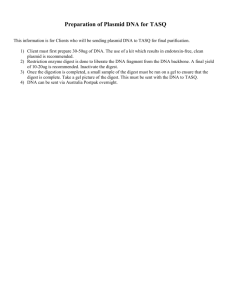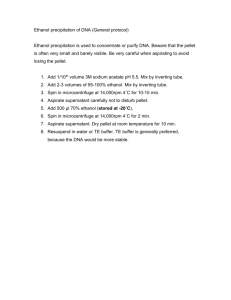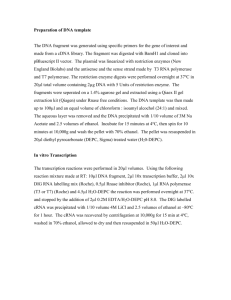T tail pL4440 and PCR ligation modified from Silencing Genomes
advertisement

T-tailing L4440 Vector and PCR Product (*Taq Pol) Ligation 1. Digest 1 μg of pL4440 DNA with 40 units of EcoRV in 100 μl at 37oC for 3 hrs or overnight. Modify conditions if using ThermoScientific FastDigest enzymes. Digest: ___ μl pL4440 ___ μl 10X restriction buffer (Promega 3) ___ μl EcoRV enzyme (20 units/μl) ___ μl autoclaved, E-Pur water 100 μl If you haven’t already done a test digest of your plasmid, including a negative control, set up a negative control “digest” of 100 ng pL4440 in a 15 μl reaction that contains no enzyme. Incubate for 3 hrs up to overnight at 37°C. It’s good practice to test that the DNA has been digested as expected before continuing, particularly if you haven’t done a test digest previously. If you’ve already done a test digest, you can check 10 μl of your reaction on a gel now or after the DNA has been precipitated and resuspended. 2. Ethanol precipitation of DNA: a. Add to the DNA solution 1/10 the volume of 3M sodium acetate and 3 volumes of 100% ethanol. For a 100 μl digest, that would equal 10 μl of 3M NaOAc and 330 μl of ethanol. b. Place the sample on ice for 10 minutes. c. Spin in a refrigerated microcentrifuge for 15 minutes (longer times are best for short fragments) at max speed (Fisher AccuSpin 75003337 rotor, 15000 rpm; 21,855g) 4°C to pellet DNA. Make sure microtube hinge is pointing up. d. Decant ethanol and gently add 500 μl of ice-cold 70% ethanol to wash pellet. Spin for 10 minutes full speed. e. .Decant all ethanol, blotting tube top with a KimWipe. Air-dry the DNA by inverting the open tube. f. Resuspend the pellet in 89 μL distilled water. Remove a 10 μl aliquot and save it for gel analysis. This should be run on a 1% agarose gel in SB with the negative control digest (see #1 above). 3. T-tail the digested vector by preparing the following reaction: DNA (vector) = 79 μL 10 x PCR buffer = 10 μL 25mM MgCl2 = 8 μL 100mM dTTP = 2 μL Taq Polymerase = 1 μL Transfer to a 200 μl, thin-walled tube for incubation in a PCR machine with the TTAIL program for 2hrs at 72°C. *Note: Be sure to use Taq Polymerase, which is nonproofreading, to ensure that an “A” will be placed at the 3’ end of the amplified product (insert). If a proofreading polymerase is used, then an “A” can be added to the ends of the amplified product using the above T-tailing reaction. Make sure protocol has a 3 minute pre-incubation at 94oC if using a HotStart Taq Polymerase. 4. Ethanol precipitate the T-tailed vector as in step 2 or use a Sephadex spin column to desalt the reaction. If you used a 200 ul thin walled PCR tube for step 3, you will have to transfer your sample to a 1.5 ml tube before (adding ethanol) and pelleting. 5. Resuspend the DNA in 30 μL of distilled water. 6. Ligate the T-tailed vector to the desired insert by preparing the following reaction: Vector (L4440) = 3 μL *PCR Taq -amplified Insert = 14 μL 10 x ligase buffer = 2 μL Ligase = 1 μL Be sure to include no enzyme (NE) and no insert (NI) controls, by eliminating the indicated reagent from the reaction and replacing with water. Incubate overnight at room temperature or according to manufacturer’s instructions. 7. Transform 1μl of each ligation reaction into 40 μl of electrocompetent NEB5α bacterial cells and plate 150 μl on an LBAmp100 selection plate. Be sure to include a positive control plasmid for transformation efficiency calculations. You will need to plate smaller volumes of the positive control plasmid.







